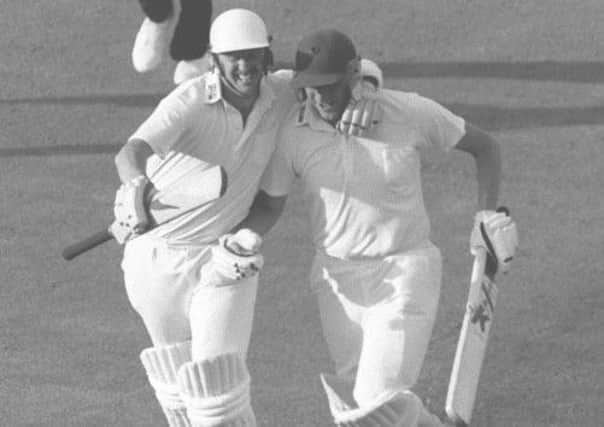Sporting Bygones: Daunting total no problem for Love as he guides Yorkshire home to thrilling Lord’s victory


Back in the 70s, the first-class counties played in three one-day competitions, the 60-over Natwest Trophy (formerly the Gillette Cup), the 55-over Benson & Hedges Cup and the John Player Sunday League, which pitted teams against each other over 40 overs.
Yorkshire won the John Player in 1983 and had enjoyed early success in the Gillette Cup after the competition was first introduced in 1963, winning in 1965 and 1969.
Advertisement
Hide AdAdvertisement
Hide AdBut, before 1987, success had eluded them in the Benson & Hedges Cup (first introduced in 1972) when Yorkshire lost to Leicestershire in the final by five wickets.
Played in the early part of summer, eight teams progressed from four groups to the quarter-finals when a traditional knockout format took over.
And, after progressing unbeaten through a group consisting of themselves, Warwickshire, Lancashire, Worcestershire and Scotland, Phil Carrick’s team clearly felt it was their year.
For the quarter-finals it was Hampshire, containing such greats as Gordon Greenidge and Malcolm Marshall, who arrived at Headingley in late May to do battle for a place in the last four.
Advertisement
Hide AdAdvertisement
Hide AdBut they rarely looked likely to progress after struggling to 174-8 from their 55 overs.
Led by 93 not out from Ashley Metcalfe – who averaged 89 in the tournament that year – Yorkshire had little trouble reaching their target, clinching victory for the loss of just one wicket and nearly 10 overs to spare.
Home advantage was repeated for the semi-finals when Surrey visited in mid-June. Poor weather meant the match was played over three days and, this time, it was Metcalfe’s opening partner Martyn Moxon – now the club’s director of cricket – to star, scoring 97 in a score of 238-7.
Despite opener Grahame Clinton scoring 69, the London club never came close, staggering to 162 all out in 48.2 overs, Arnie Sidebottom topping the bowling figures with 3-29.
Advertisement
Hide AdAdvertisement
Hide AdThe final, at Lord’s on Saturday, July 11, brought them up against Northamptonshire, who made it through in scintillating style when chasing down Kent’s 275 at Canterbury courtesy of Alan Lamb’s superlative 126 not out.
Yorkshire were given a fair total to chase down themselves on a warm, sunny day at the home of cricket, Northants posting a challenging 244-7 thanks to David Capel’s 97.
Paul Jarvis helped keep Northants in check with the ball, taking 4-43 from his 11 overs.
Yorkshire got off to a solid start in their reply, Moxon (45) and Metcalfe (47) sharing an opening partnership of 97.
Advertisement
Hide AdAdvertisement
Hide AdBut after quickly finding themselves down to 103-3, Jim Love and Kevin Sharp came together at the crease. And it was the experienced Love who took the lead role to guide his team to within sight of the finish line, a 57-run partnership with Sharp (24) being followed by another of 63 with David Bairstow, run out for 24. Carrick was also run out, for 10, which brought Arnie Sidebottom to the crease.
The opening bowler was almost run out off the next-to-last ball but, having drawn level with their opponents, all Love had to do was avoid dismissal off the final delivery. He duly did and sealed a dramatic victory by virtue of losing fewer wickets, while also seeing Yorkshire become only the fourth county after Essex, Kent and Lancashire to complete the full set of domestic trophies.
Looking back, Love remembers a Yorkshire team confident that they could chase down whatever total Northamptonshire had asked them to.
“It was a decent total that Northants gave us to chase,” said Love. “But I don’t think it frightened us at all – we had a good batting line up at the time.
Advertisement
Hide AdAdvertisement
Hide Ad“It was damage limitation when we were fielding – trying to keep them to a score we could get. We always felt, though, that we could get that score if we played right.”
Love, who played three one-day internationals for England in 1981, said he felt confident he could see his team homeas soon as he walked out to the middle.
“From ball one when I went into bat that day I felt in really good nick and it was one of those times where you say to yourself ‘if you don’t do anything silly here you could bat all day’ and it was a fantastic wicket one of the best wickets I’d played on.
“I guess you could say we made it interesting – maybe a bit too interesting for some, including my mum and dad who were on the edge of their seats.
“We heard later that some cricket clubs in Yorkshire actually stopped playing to watch the last few balls before going back out again to finish their games off.”